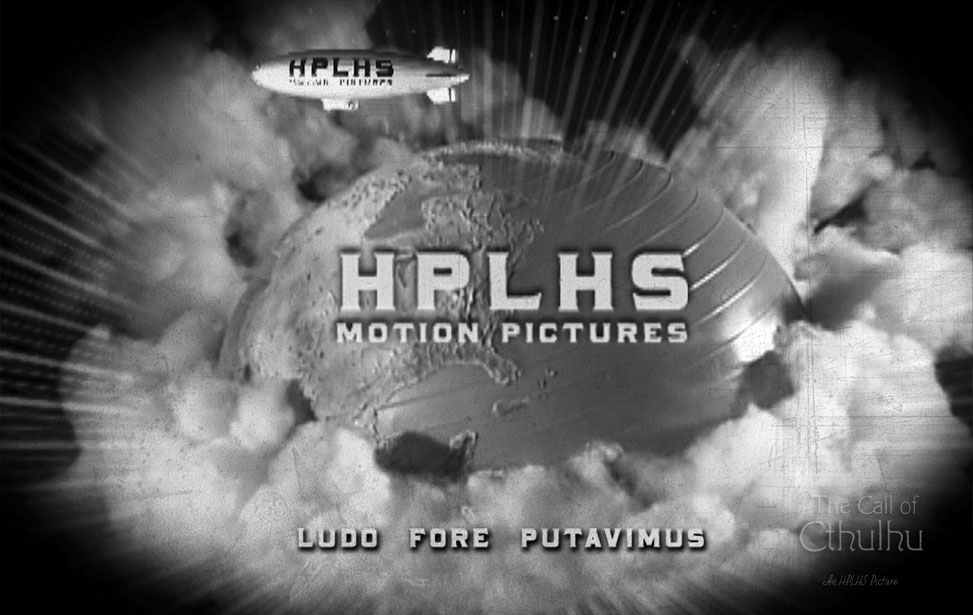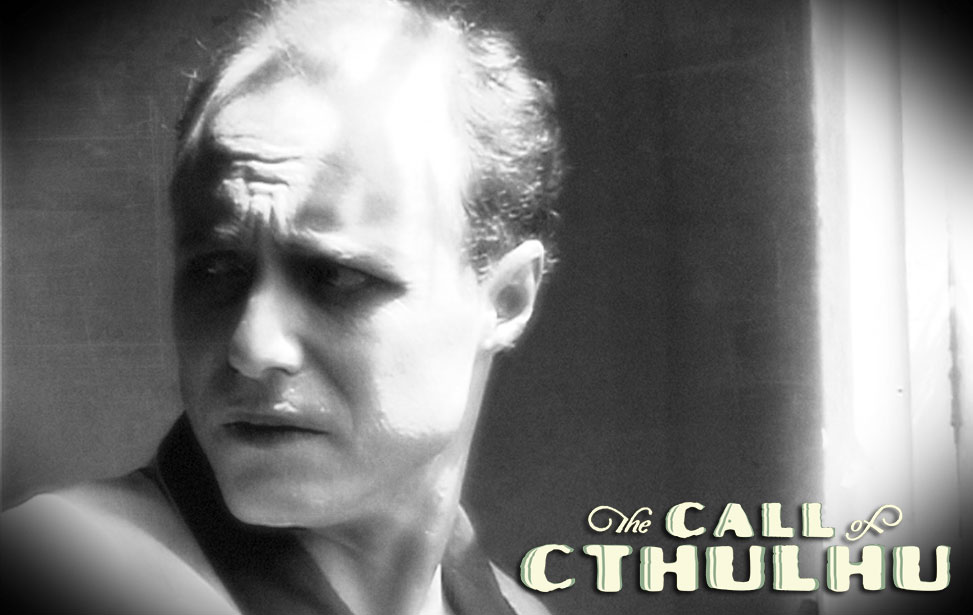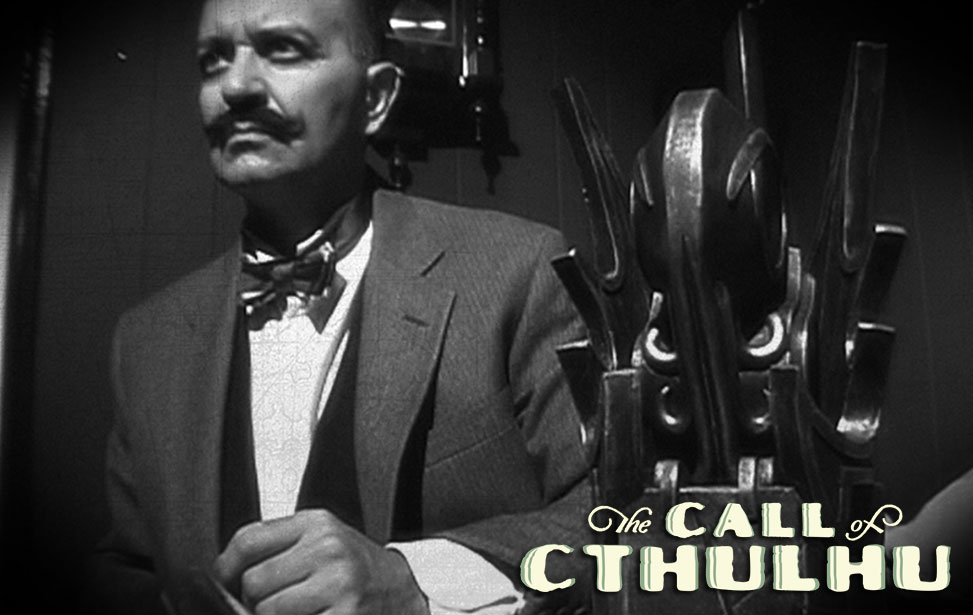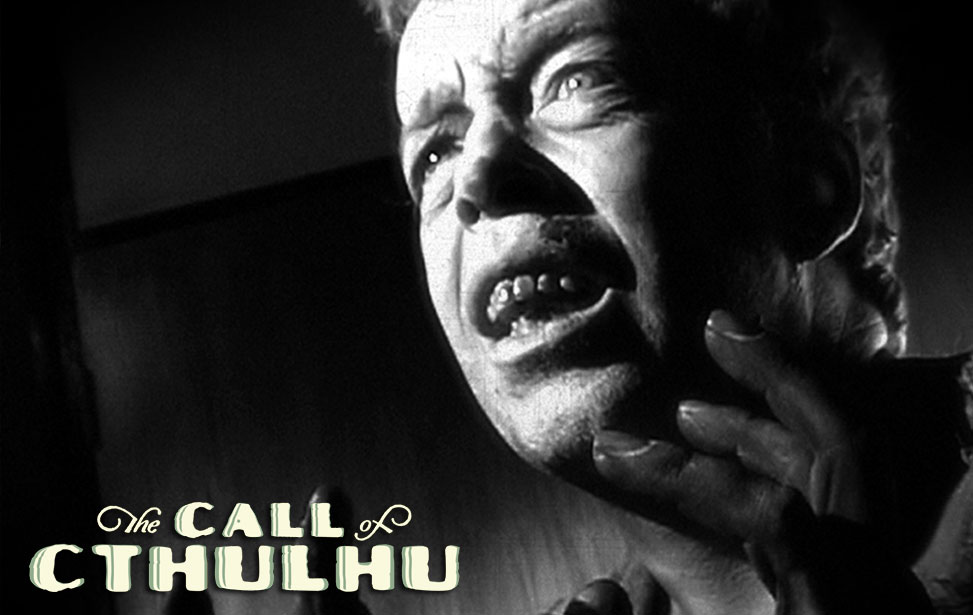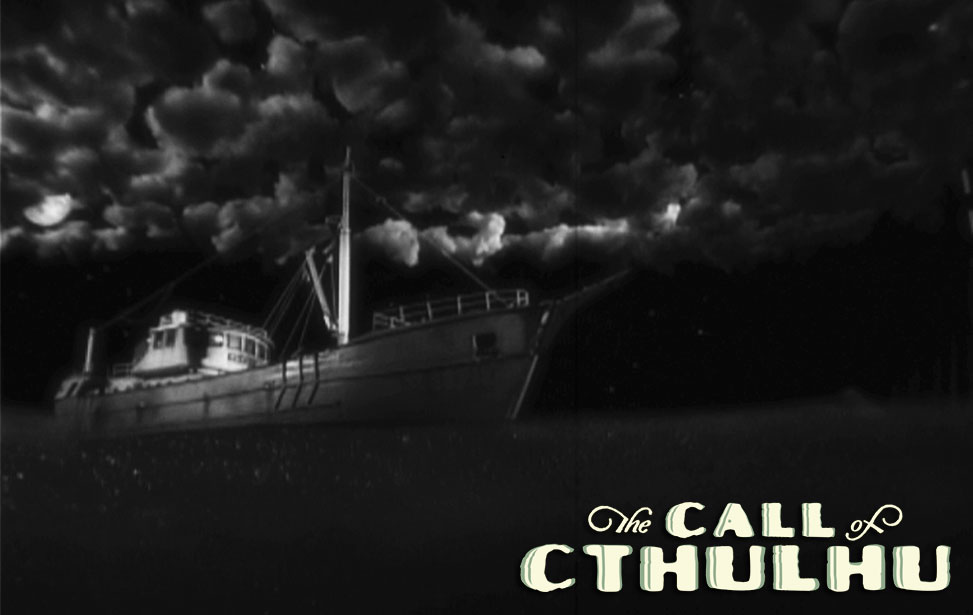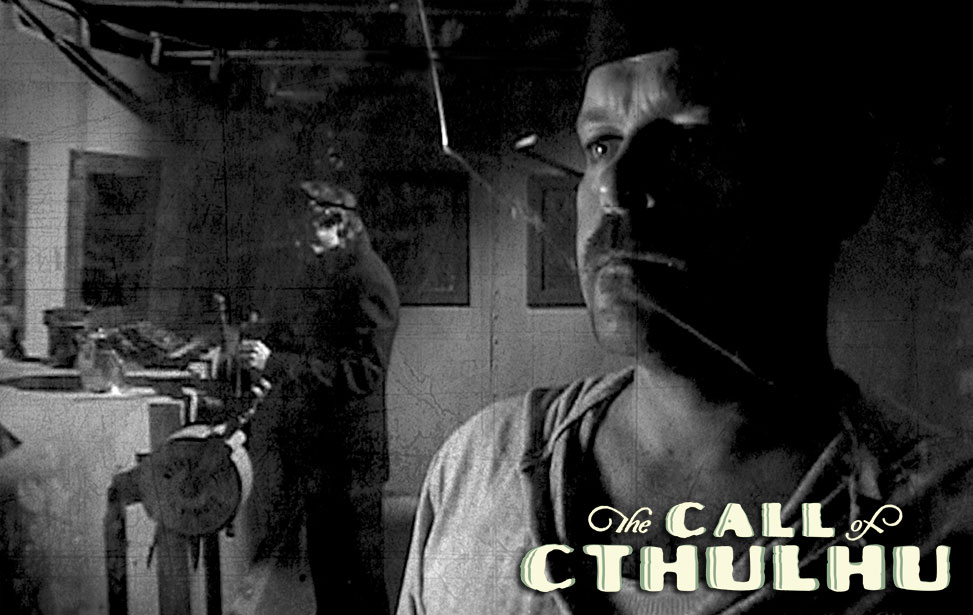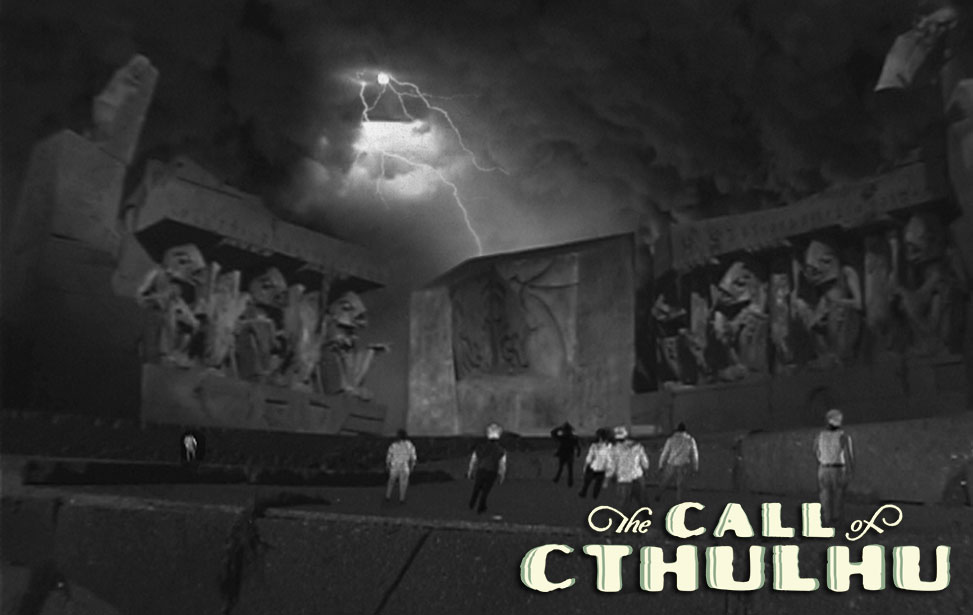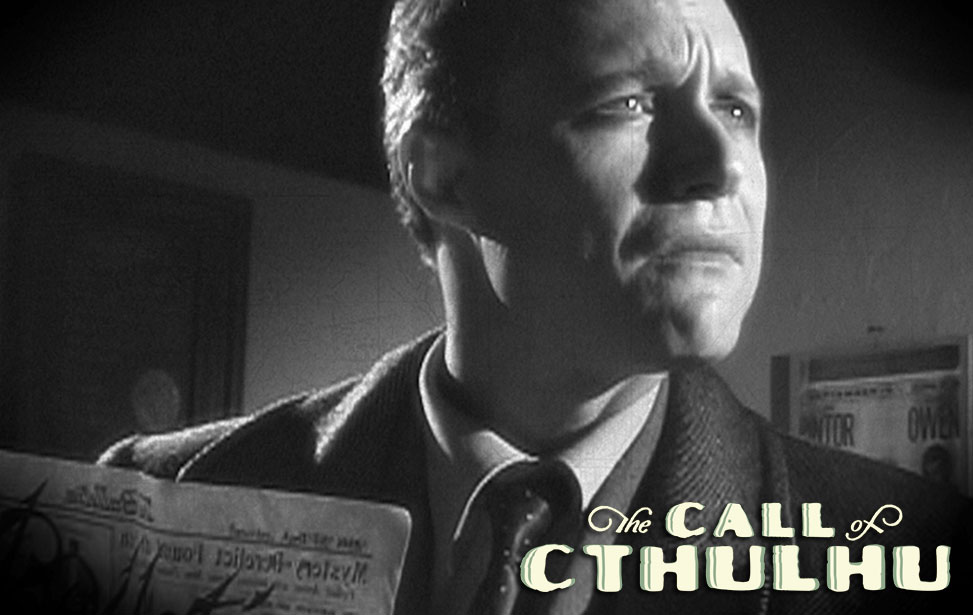
Classical Lovecraft
The H.P. Lovecraft Historical Society is proud to present its widely acclaimed and award-winning silent film of The Call of Cthulhu. A dying professor leaves his great-nephew a collection of documents pertaining to the Cthulhu Cult. Crossing decades and continents, the man begins piecing together the dread implications of the professor's inquiries. Written in 1926, the famed story is brought richly to life in the style of a classic 1920s silent movie, with a haunting original symphonic score. Using the Mythoscope™ process — a mix of modern and vintage techniques — the HPLHS has worked to create the most authentic and faithful screen adaptation of a Lovecraft story ever attempted.
After playing at numerous film festivals across the world, this extraordinary motion picture is available on DVD, featuring a making-of documentary, high-fidelity and Mythophonic audio, special features, and intertitles in twenty-four languages.
Get it now!Production Team
From the Celebrated Story by H. P. Lovecraft
Adapted for the Screen by Sean Branney
Produced by Sean Branney and Andrew Leman
Original Music by Troy Sterling Nies, Ben Holbrook, Nicholas Pavkovic and Chad Fifer
Costumes by Laura Brody
Makeup by Andra Carlson
Associate Producer Chris Lackey
Special Visual Effects by Dan Novy
Photographed and Edited by David Robertson
Directed by Andrew Leman
The Players
In the order of their appearance:
The Man... Matt Foyer
The Listener... John Bolen
Professor Angell... Ralph Lucas
Henry Wilcox... Chad Fifer
Landlady... Susan Zucker
Prof. Webb... Barry Lynch
Prof. Bell... John Klemantaski
Prof. Quintana... Jason Owens
Prof. Tutchton... D. Grigsby Poland
Bartender... Kalafatic Poole
Inspector Legrasse... David Mersault
Eskimaux Shaman... Dan Novy
Sgt. Bacon... John Joly
Officer Stanton... Jason Peterson
Officer Langfield... Matthew Malcomson
Officer Cassidy... Daryl A. Ball
Swamp Papa... Ed Ruffin
Swamp Mama... Erika Zucker
Swamp Aunt... Rebecca Marcotte
Swamp Boy... Aidan Branney
Swamp Girl... Hannah Rose Jabaley
Swamp Baby... Ike “E.Z.” Jabaley
Thibidoux... Richard Lucas
Claude... Bruce Graham
Tilly... Jennifer Knighton
Louis... Ramón Allen, Jr.
Nancy... Erin Emmalee
Tyler... Steven O’Connor
Hector... Carlos Linares
Castro... Clarence Henry Hunt
Nameless Cultists... Aaron Vanek, Kirsten Hageleit, Jonathan Putnam, Mona Weiss, Dan Novy, Ryan Oliver, Chia Evers, J. David King
Captain Collins... Noah Wagner
Johansen... Patrick O’Day
Briden... Matthew Q. Fahey
Parker... Chris Lackey
Hawkins... Josh Thoemke
Guerrera... Mike Dalager
Ångstrom... Daniel Kirsner
Rodriguez... David Pavao
Pub Man... Sean Branney
Unhelpful Bureaucrat... Andrew Leman
Museum Clerk... Vivica Prentice
Mrs. Johansen... Leslie Baldwin
Nurse... Andra Carlson
Reviews
The Call of Cthulhu was met with enthusiastic support by audiences and critics alike. Below are some excerpts from various reviews.
 The Stranger
Seattle
The Stranger
Seattle
An absolutely gorgeous telling of HP Lovecraft's cult story. Every note is hit exactly right... the end result will leave you delirious. [a] must-see... a gorgeous, haunting, pitch-perfect mini-epic.
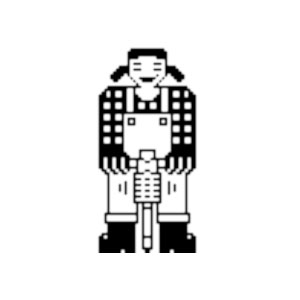 by Craig Engler
boing boing
by Craig Engler
boing boing
...This is one of those genius, word-of-mouth, Hollywood-will-never-understand-it kind of films. ...Best $20 I ever spent on a DVD.
 by Ray Young
Flickhead
by Ray Young
Flickhead
Directed by Andrew Leman from a screenplay by Sean Branney, The Call of Cthulhu is determined to be faithful. It runs under an hour, thankfully avoiding the fleshing out of scenes and characters to meet those unwritten rules of feature length. There is a lot to be said for such consideration—as well as reminding us that movies needn’t fall back on superfluous baggage simply to fill for time. Leman braves a unique gimmick by utilizing standards of the time the story was written, filming in black and white, silent (complete with decorative title cards and subtle aging devices superimposed on the image), enhanced by a rousing musical score. For scenes with the monster, stop-motion animation was revitalized in lieu of CGI. There are several instances when Branney’s screenplay is in absolute control of the suspense within the source material, building to a heated climax.
 by James Lynch
Green Man Review
by James Lynch
Green Man Review
So how does this vast, multi-storied tale come across as a low-budget silent movie? Impressively well. Director Andrew Leman does an excellent job handling The Man's growing understanding of the connection between events, the calm of characters who don't know the extent of the events around them, and the action of the swamp raid and frantic flight from the island of R'lyeh. Word cards aren't used for every utterance, but they provide enough information for viewers to piece together the rest of the dialogue from the gestures and mannerisms of the actors. (Fans of Lovecraft's most famous story will have no problem reading the lips of the character that first utters that famous unpronounceable name.) Hear the call of this silent movie and watch The Call of Cthulhu. This adaption would make H.P. Lovecraft proud.
 by John Boonstra
The Hartford Advocate
by John Boonstra
The Hartford Advocate
The very best thing about it is its chosen method of presentation. Cthulhu is a black-and-white silent film, which proves brilliantly appropriate for a yarn written in 1926, the very end of the silent era. Director Andrew Leman and scripter Sean Branney serve Lovecraft´s words and mood faithfully, as the story of an unnamed man (Matt Foyer) relating stories within stories to a doctor at what must be a mental institution. The man has inherited reams of research from his uncle, and through those documents, and then through our protagonist´s further research, pieces of a puzzle are assembled, all pointing to the existence of a demon-worshipping cult. The more you know about Lovecraft and his overwrought, tightly wound horror fiction, the more you´ll appreciate the fine details in this small gem.
 by Phobia
shoggoth.net
by Phobia
shoggoth.net
It must be stated: "The Call of Cthulhu" is the dominant film adaptation of a Lovecraft tale. This movie will soon become the high-bar to which future Lovecraftian movies are measured. First and foremost is the excellent acting. Even without dialog these actors put on amazingly convincing performances. The symphonic score is simply awesome. Obviously influenced by silent films of the past the score heightens the tension and accentuates the action; essentially, it completes the film. The HPLHS has amazing attention to detail, and no detail was spared here. The sets and wardrobe all appear period and the props are excellent. The special effects, especially during the R’lyeh scenes are great. The scenes in the Louisiana swamp are another highlight; how could one-hundred silent but screaming cultists be wrong?
 by Madison Carter
Hero Realm
by Madison Carter
Hero Realm
The Great Old Ones are back, and they haven’t looked better. For those who are familiar with the lore of Lovecraft, you will be heartened by the fact that this is an incredibly faithful adaptation of the titular story. The entire film production is set up to resemble the old silent films, the kind of motion picture that would have existed when the story was originally written. Shot in black and white, the silent film is extraordinary at some of its recreations of a bygone era (purposely created damage, “hair” in the projector) and only gives away its true nature in some of the film stock, which is not quite like that used almost a century ago. Not only is CTHULHU faithful, but it’s damned good, silent or not. It builds its moments of dread at just the right points and moves along at a clip that would do its source justice.
 by Scott Weinberg
Hollywood Bitchslap
by Scott Weinberg
Hollywood Bitchslap
The Call of Cthulhu, on the other hand, is absolutely a Lovecraft adaptation -- and it's an entirely awesome expenditure of 47 minutes. Halfway through this lovingly crafted and wonderfully reverent mini-movie I leaned over to a critical colleague and said "Dude ... this is some really good stuff!" His response: "It absolutely is! Who put this thing together??" Andrew Leman and Sean Branney, creators of the H.P. Lovecraft Historical Society, are who put this thing together -- and if every "fan-made" movie were this curiously cool and bizarrely entertaining, well, it'd put a lot of Hollywood suits out of a job. I could rant and rave about the silent movie "gimmick" or the drop-dead wonderful musical score; the painstakingly difficult work that comes with the "old-school" look of the movie; or the wonderfully dreadful atmosphere that bubbles up from every frame of the flick, but you'll just have to trust me on this one.
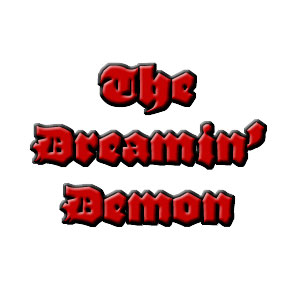 by Morbid
The Dreamin' Demon
by Morbid
The Dreamin' Demon
Every single one of the actors in Call of Cthulhu, all wearing pancake makeup, do an exceptional job with the material and most of their acting coming from facial expressions and body language. Using masterful scene transitions to mark the narration within-narration style of the story, Andrew Leman keeps the viewer engrossed throughout the entire film and with the help of cinematographer David Robertson, succeeds in bringing scenes that are beautiful, frightening and hard to forget. The music in The Call of Cthulhu is an achievement in itself. Created by Chad Fifer, Ben Holbrook, Troy Sterling Nies and Nicholas Pavkovic, these guys did an exceptional job. From simple conversations, to action sequences, the score to this film ranges from calming, epic, to frightening.
The Crew
Key Grip... Matthew Q. Fahey
Grip... Ryan Oliver
Production Assistant... Mona Weiss
Catering/Craft Services... Leslie Baldwin
Music Supervisor... Chris Horvath
Providence Liaison... Anthony Penta
Props, Puppets & Miniatures... Andrew Leman
Swamp Idol... Bryan Moore
Eskimaux Idol... Chris Lackey
Stop-Motion Cthulhu Armature... Terry Sandin
Production Illustrator... Darrell Tutchton
Wilcox Dream Cthulhu... Harold Arthur McNeill
Special Thanks
These people went above and beyond the call of duty in helping us make this movie. We thank them for their generosity and support.
Adam Austin
Seb Borges
Paul Brinkman
Brad Brusavich
Dan Conroy
Kirsten Hageleit
Gary Isaacs
John Jabaley
Mark Krewatch
Ken Lobb
Barry Lynch
Pascal Marcotte
Martin McClendon
Tamara McDonough
David Mona
Bryan Moore
Gina Morey-Risemberg
David O
Stephanie Obodda
Nick Offerman
Anthony Penta
Heather Saenz
Janaya Smith
Aaron Vanek
Noah Wagner
Wayno
Janette Yamaguchi
Joe Zinnato and Eros Archives
An Claideamh Soluis/The Celtic Arts Center of Southern California
Chaosium, Inc.
Flash Film Works
The Providence Art Club & the Residents of the Fleur de Lys Studio
The San Marino Police Department
Reference Librarians at the State Library of Queensland
Theatre Banshee
all the Cast and Crew
The HPLHS Volunteer Translator Corps
These people all graciously volunteered their time to share this film with a wider audience. To this best of our knowledge, this is the 1st DVD ever to be released including Galician or Luxembourgish translations. If you find errors in their translations, it's probably our fault. We are very grateful to them all.
Segis Alonso - Galician
José Beltran-Escavy - Castellano
Josep Francesc Braut - Catalán
Jeppe Buchreitz - Danish
Marcelo Carreiro - Portuguese
Giorgio Cefaro - Italian
Charlie and Donal Cunningham - Irish
Marte Fagervik - Norwegian
Nomad von Fblodilovich - Hungarian
Tom Flener - Luxembourgish
Doruk Golcu - Turkish
GOREGONNA, Ania Staniszewska and Lukasz Hak - Polish
Jenny Heldestad - Swedish
Alex Itoafa - Romanian
Petr Janecek - Czech
Ifan Jones - Welsh
Marleen Kroeders - Dutch
Pijui Kruminui - Lithuanian
Pascal Marcotte - French
Christoffer Nygaard - Norwegian
Juha-Matti Rajala - Finninsh
Rik Rösken - Dutch
Ulrich Schreitmueller - German
Nathalie and Anastasia Stepic - Croatian
Clara Torcal - Euskera
Jean-Francois “Jeff” Trudel - French
Yasemin Türkeli - Turkish
Piotr Wierzejewski - Polish
The Production Process
For the fourteen months of shooting The Call of Cthulhu, Sean Branney kept an online journal sorta thing and dished out some stills from the production. Read the tale of agony and ecstasy in the world of low-budget Lovecraftian filmmaking.
In the Beginning
Our first weekend of shooting was in a lovely Victorian house in Pasadena. It was brutally hot and a very challenging weekend of shooting. We were able to use the house for four location though, and no one actually passed out from heat exhaustion. Ah California in summertime. Without air conditioning... The third day of shooting we moved to our pal (and fellow Lovecraftian filmmaker) Bryan Moore's Arkham Studios. Bryan's hospitality combined with air conditioning made for a much more pleasant shoot.
The Studio and Beyond
Our second weekend of shooting involved a return to Arkham Studios and shooting at two public beaches in the Los Angeles area. Our first night we converted two other parts of the studio into Legrasse's office and the Sydney Museum. Again, innovative lighting by Dave Robertson created very distinct looks for the different scenes shot at the same location.
An early start and cooperative fog got us off to a good start. Unfortunately an actor forgot to bring a key hat from home. Our amazing costumer, Laura Brody actually managed to cut fabric from the hem of an actor's pants and fashion it into a completely suitable hat, all in the back seat of a car at the beach. Laura is amazing. Our first location, on the cliffs by the beach had been tagged with graffiti since our scouting trip and we were forced to improvise. With some Spider-Man-like moves, our Director of Photography, David Robertson managed to setup some excellent shots.
Our streak of excellent luck in not getting arrested continued as we moved to another busy beach location for another shot. The police, street mimes and fishermen left us alone and we were able to get our footage and run. We wrapped the day by shooting in the bedroom of Hollywood apartment owned by another obliging friend. Once again David's ability to get a shot while hanging his body precariously proved of great use. Again, no air conditioning, but a smaller crew and shorter scene made for a pleasant shoot.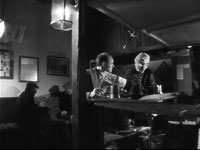 Our friends at the Celtic Arts Center in Studio City were most kind to let us use The Snug, their clandestine back-room pub as our New Zealand tavern. With some imaginative lighting we were able to capture the feeling of a dingy Wellington watering hole.
Our friends at the Celtic Arts Center in Studio City were most kind to let us use The Snug, their clandestine back-room pub as our New Zealand tavern. With some imaginative lighting we were able to capture the feeling of a dingy Wellington watering hole.
A key part of low-budget filmmaking is to get your friends to let you shoot at their locations. You have perhaps noticed by now that we have many kindly friends who have helped us in this film. Our next location was provided to us by Joe and Laura of Eros Archives: one of the leading dealers of vintage erotica. Yes, we filmed in warehouse filled with vintage smut, right in the heart of the San Fernando Valley. 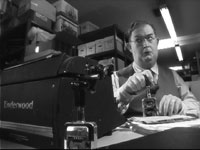 Yet with the miracle of film (and Andrew Leman's relentless dedication to vintage office supplies), the erotica warehouse transformed itself very neatly into an Australian government records office.
Yet with the miracle of film (and Andrew Leman's relentless dedication to vintage office supplies), the erotica warehouse transformed itself very neatly into an Australian government records office.
The Big One
Our previous weeks of shooting were preparations for the big shoot of mid-August. We needed to get footage of Legrasse his men in the swamp, the crazed dancing cultists, and The Man in the sunroom. We came to the conclusion that the swamp sequences needed to be shot on a set rather than in a real swamp. Swamps are hard to come by in Los Angeles in the summer, and the shots we needed would be hard to setup and light in a real swamp. So, after doing some scouting, we settled on renting a sound stage. Visualiner is a huge facility in Culver City, with a theatre, big empty spaces, and built-in strip club set (complete with stripper poles). The plan was we would build a swamp, take it to Visualiner, assemble it, shoot the swamp sequences, then shoot the green-screen sequences with the cultists, shoot the Sun Room scenes and finally shoot some more green screen footage.
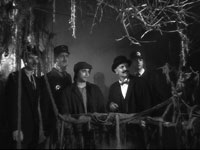 It's hard to build a swamp from scratch, but with some help from our friends, lots of fabric, yarn and paper maché, we managed to assemble a swamp complete with ten massive trees. It looked pretty absurd in person, but with light, fog and actors, we were happy with the final results. The swamp was used for just one day of shooting with the cops and the cultists before it was struck and stuff into dumpsters.
It's hard to build a swamp from scratch, but with some help from our friends, lots of fabric, yarn and paper maché, we managed to assemble a swamp complete with ten massive trees. It looked pretty absurd in person, but with light, fog and actors, we were happy with the final results. The swamp was used for just one day of shooting with the cops and the cultists before it was struck and stuff into dumpsters.
Norway
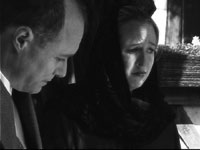 After scouting numerous location to use as the Johansen house in Norway, we eventually settled on the so-called Snow White cottages in Silver Lake (a neighborhood in Los Angeles). These apartments look as if they were built to be part of Disneyland and they provided an old-world quaintness that's hard to find in this part of the world. We brought in our very agreeable actors and quickly shot some terrific footage of The Man's visit to Johansen's widow in Norway.
After scouting numerous location to use as the Johansen house in Norway, we eventually settled on the so-called Snow White cottages in Silver Lake (a neighborhood in Los Angeles). These apartments look as if they were built to be part of Disneyland and they provided an old-world quaintness that's hard to find in this part of the world. We brought in our very agreeable actors and quickly shot some terrific footage of The Man's visit to Johansen's widow in Norway.
Effects Shots
We cracked out the camera again to get some needed coverage for the trailer for The Call of Cthulhu which is scheduled to be released at the HP Lovecraft film festival the first weekend of October. Using a theatre where Sean currently has a play running, we setup four different shots. The studio logo shots with the globe and zeppelin were shot here. We also shot R'lyeh sinking and Cthulhu himself for the trailer.
Swamps Are Wet
We set in for the final push to finish all the live action shots. Among these are a shot of Legrasse and his men in the paddy wagon and the Swamp Family telling Legrasse about the terrible things happening in the swamp. After much searching we managed to get permission to borrow a real 1910 era paddy wagon from a certain police department. We were all set to shoot when we got word that the mechanic who was prepping the car for us left it in gear and it crashed into a tree. It's being fixed....
As for the Swamp Family shot, we found a swamp shack and lined up and 9 actors for the scene. The song says, "It never rains in Southern California". It hasn't rained here in about 6 months. So, you can all guess what happened out at the swamp shack. Fortunately, only the crew got incredibly soaked, no equipment was permanently ruined, our host's house only blew some fuses, and no one was injured or arrested. We wrapped the evening by changing locations to somewhere warm and dry and getting some great footage of The Man working on geologic specimens in the museum.
R'lyeh in the Back Yard
The Plan
As the movie heads towards completion, we knew we'd have to film in R'lyeh. Not some namby-pamby model or digital effects shot; we need to build a real 3D R'lyeh set to complete the movie. Andrew Leman, knew it would drive him to insanity to try and draw a blueprint of R'lyeh, so he opted to build a scale model. It came out very nice, was suitably bizarre and I liked it a lot. Until I asked him what the scale was. His model meant we would have to build a set 35 feet wide, 16 feet deep and 25 feet high. Something the size of a small house. It had to be structurally sound enough for 8 actors plus filming crew to climb around on it. Oh yes, and its geometry is so weird that part of the set needed to be capable of eating an actor.
Our incredibly obliging friends Noah and Brad said we could use their backyard for shooting. Had they known how big this thing would be and what we'd do to their yard, I'm sure they never would have agreed. But they did and soon we were grappling with the incredible cost of the amount of lumber needed to build this thing. In a flash of brilliance, scaffolding came to mind.
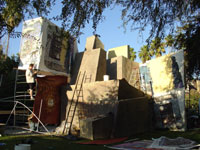 Cheap, metal, strong, easy to assemble... a perfect solution. Soon Leman, Branney, Barry Lynch and Matt Fahey had assembled six sets of scaffolding, topped with six theatre platforms. On top of those went flats (false walls used in theatre productions). Then came cardboard, lots and lots of cardboard. While very vulnerable to wind and rain, cardboard gave us a cheap and flexible material to use to face the stone surfaces of R'lyeh.
Cheap, metal, strong, easy to assemble... a perfect solution. Soon Leman, Branney, Barry Lynch and Matt Fahey had assembled six sets of scaffolding, topped with six theatre platforms. On top of those went flats (false walls used in theatre productions). Then came cardboard, lots and lots of cardboard. While very vulnerable to wind and rain, cardboard gave us a cheap and flexible material to use to face the stone surfaces of R'lyeh.
R'lyeh required fabric, huge amounts of fabric. Fortunately Branney (who runs Theatre Banshee) had just finished a production which used huged pieces of fabric in its set design. We quickly cut down the 9x9 fabric panels, brought them to this set and used them to face the 10x20 towers of scaffolding. More fabric still was required to build the ocean that surrounds R'lyeh. A special diaphanous shimmery blue material was found which creates a very nice water effect (particularly when shot in black and white at night).
We painted and painted and painted. Then we added a dinghy. And in less than a week, we created a massive Cthulhoid play-structure, capable of being filmed from many angles and meeting the needs of the story.
Wednesday
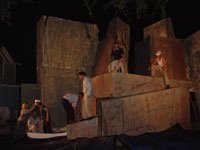 We gathered the cast, crew, wardrobe and makeup teams and got the sailors ready for their first arrival at R'lyeh. Everyone (especially us) was pleased to see the structure could hold up the whole cast and it could be photographed from a variety of interesting angles. The terrified sailors clambored over cyclopean blocks of cardboard as we shot many scenes of them exploring the city.
We gathered the cast, crew, wardrobe and makeup teams and got the sailors ready for their first arrival at R'lyeh. Everyone (especially us) was pleased to see the structure could hold up the whole cast and it could be photographed from a variety of interesting angles. The terrified sailors clambored over cyclopean blocks of cardboard as we shot many scenes of them exploring the city.
Thursday
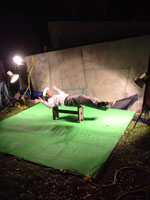 We came back with a slightly smaller group of actors to get coverage of additional scenes. The temperature dropped considerably (quite a hardship for us thin-blooded Californians). Thursday's particular challenge was to get the actor playing Rodriguez falling off of the top of Cthulhu's tomb into the miasmal void below. David Pavao was quite a good sport as we asked him to do many painful things over and over again. We realize that the stills we're showing you here look incredibly goofy. But when you see the images through the lens of the real camera, in black and white, we think you'll be pleasantly surprised at how good this cardboard monstrosity looks.
We came back with a slightly smaller group of actors to get coverage of additional scenes. The temperature dropped considerably (quite a hardship for us thin-blooded Californians). Thursday's particular challenge was to get the actor playing Rodriguez falling off of the top of Cthulhu's tomb into the miasmal void below. David Pavao was quite a good sport as we asked him to do many painful things over and over again. We realize that the stills we're showing you here look incredibly goofy. But when you see the images through the lens of the real camera, in black and white, we think you'll be pleasantly surprised at how good this cardboard monstrosity looks.
Friday
The entire cast was assembled one more time and with the aid of a taller ladder (14 feet placed on top of the main deck already 11 feet off the ground) we were able to get some more great coverage. Late in the evening we moved onto perhaps the trickiest shot of R'lyeh: where Parker gets devoured by the architecture.
To get the shot we built a part of the set which contains an inward 90 degree angle which when properly lit appears to be an outward 90 degree angle. Using this, the actors would jump off of one platform, land on another and then the actor (Chris Lackey) playing Parker would fall backwards into the negative space. It sounds pretty easy but actually required quite a bit of courage as Chris would have to fall backwards, blindly into a hole, hoping to land on the foam cushions hidden somewhere below in the darkness. Chris' mind came around to the idea of what was required of him, but his body remained resistant. Eventually though, we fed Chris to the angle several times and it looked pretty damned cool as R'lyeh swallowed him up.
By 2am on Friday night, we wrapped shooting in R'lyeh. It's since been dismantled, and hauled off to the dump and another location where elements from this set will be recycled.
The Paddy Wagon
 After our first several attempts to shoot the antique paddy wagon were sabotaged by weather, mechanics, location problems and the like, we scheduled it again. This time we sent a flat-bed tow truck to the Police Headquarters of a certain southern California town (we don't want anyone getting in trouble). We loaded up the car and set out for Branney's back yard with the paddy wagon, a squad car and Officer Aaron, a real police escort for the vehicle. Because no one on the set was actually qualified to drive this antique vehicle, we labored to push it up a steep driveway and get it into place. Andrew retro-fitted the car with a set of electrical lights (the original lights are gas powered) and a magnetic New Orleans Police sign. Clever use of lighting and fog transformed Branney's back yard into a bona fide Louisiana swamp with an authentic period police vehicle.
After our first several attempts to shoot the antique paddy wagon were sabotaged by weather, mechanics, location problems and the like, we scheduled it again. This time we sent a flat-bed tow truck to the Police Headquarters of a certain southern California town (we don't want anyone getting in trouble). We loaded up the car and set out for Branney's back yard with the paddy wagon, a squad car and Officer Aaron, a real police escort for the vehicle. Because no one on the set was actually qualified to drive this antique vehicle, we labored to push it up a steep driveway and get it into place. Andrew retro-fitted the car with a set of electrical lights (the original lights are gas powered) and a magnetic New Orleans Police sign. Clever use of lighting and fog transformed Branney's back yard into a bona fide Louisiana swamp with an authentic period police vehicle.
The Original Score
As soon as you see The Call of Cthulhu, you realize the term "silent film" really isn't appropriate. True, there is no dialogue or sound effects, but there is most definitely sound. Sound is an essential component of all films, but particularly silent films. The score of The Call of Cthulhu is the heartbeat of the film.
Due to a staffing change, late in the process of making the movie, we found ourselves without a composer. We sent out calls, talked to people, begged and wheedled and ended up gathering a team of five composers to create an original score.
Troy Sterling Nies
Troy wrote to us to volunteer his services just about the time we really needed them. With cruel and unusual time deadlines, Troy composed more of the soundtrack than anyone else and did an astouding job. His music captures both the sound of period orchestra and the dramatic tension of the story's most exciting moments.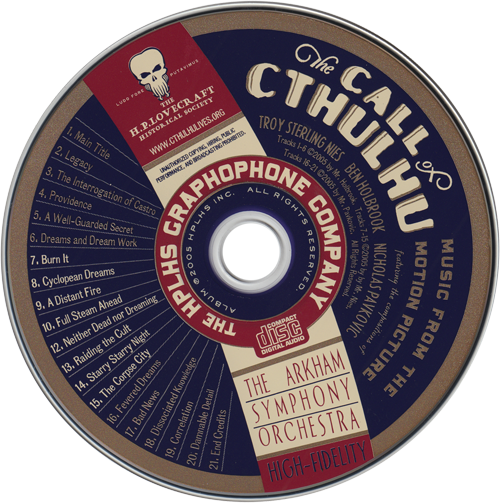
Ben Holbrook
Ben wrote a number of pieces for the film, bringing nuance and atmosphere to the period sound. Unshaken by preposterous deadlines, Ben composed music that sets the tone and atmosphere of the film.
Nicholas Pavkovic
In addition to the closing credits and other pieces, Nick provided the movie with many of its essential bridges - scenes which transition from one part of the story to another. His bridges carry the film's momentum, while allowing for significant changes in musical tone.
Chad Fifer
Composer, actor, writer and Wilcox in The Call of Cthulhu, Chad also provided a number of short pieces of music which are sprinkled throughout the film. These audio gems give spice to the unfolding action.
David O
Famed Los Angeles musical theatre composer/director/arranger/performer David O took on our commission to write music for the film. Unfortunately in the end we were not able to fit David's compositions into the final cut of the film, but we remain grateful for his contributions to the project.
The Production Process: Completion
At Sea
 The last major sequence to be shot involves the sailors from the Emma boarding the abandoned ship, The Alert, before they go ashore at R'lyeh. After chatting with the locals on R'lyeh, they paddle for their lives to get back to The Alert, ram Cthulhu with the ship and limp away from the accursed place. This makes for a very good story, however, it's a serious challenge for low-budget filmmakers. The ship sets not only needed to be realistic, they needed to be built (a) to match the models of the respective ships and (b) look like 1920s movie sets. Not ones to be easily thwarted though, Leman and Branney and able crew set about building sets for the two ships.
The last major sequence to be shot involves the sailors from the Emma boarding the abandoned ship, The Alert, before they go ashore at R'lyeh. After chatting with the locals on R'lyeh, they paddle for their lives to get back to The Alert, ram Cthulhu with the ship and limp away from the accursed place. This makes for a very good story, however, it's a serious challenge for low-budget filmmakers. The ship sets not only needed to be realistic, they needed to be built (a) to match the models of the respective ships and (b) look like 1920s movie sets. Not ones to be easily thwarted though, Leman and Branney and able crew set about building sets for the two ships.
Because the script only has the sailors on the schooner, The Emma, briefly, we fashioned a deck, railing, some rope rigging and sails. With fog machines, a massive fan, and water spritzing by the makeup department, we were able to capture a nice quick scene on The Emma. The Alert, is another story.
The set of The Alert needed to provide interior and exterior views of the wheelhouse of a run down commercial fishing vessel. Our friend Nick Offerman provided us warehouse-type space adjoining his excellent woodworking shop. For a week we toiled like maniacs using 1x2s, luan (thin plywood), cardboard, plexiglass, vintage scientific equipment, accurate nautical charts, a severed finger and several hundred wooden nubs to create The Alert's wheelhouse.
We finished painting the set as the cast was getting into makeup (notice no one grabs the ship rail; it's paint is still wet). We shot late into the night, our stalwart crew joined by Aaron Vanek (behind the scenes video and photos) and Kirsten Hageleit (swinging light fixture operator). We captured great footage of the pre-R'lyeh action on the ship. Next week we'll be back aboard The Alert to film the desperate panic that follows face-time with Cthulhu.
Action Movie
After reviewing the footage of the ship The Emma in the storm, we decided the shot would be better if we put the camera in the ocean and filmed onto the deck, rather than visa versa. We fired up rain, wind and fog and got far superior coverage of the scene in which the sailors of The Emma are battered by the storm and spy the abandoned ship, The Alert.
We booked the rest of the day of shooting to cover the sequence that follows the surviving sailors once they've returned to The Alert and prepare for the final confrontation with Cthulhu. While this sequence will be less than 30 seconds of the finished film, the shots were pretty complicated and needed to be done right. Experimentation led to some excellent lightning effects, some experimental makeup looked excellent, and cast members Dan Harper and Matt Fahey shined as they drove their ship in terror.
Row, Row, Row Your Boat
Recycling elements from the set of The Alert plus a few theatre productions, we built the hull of The Alert for the shots when the fleeing sailors approach in their rowboat and climb back aboard their ship. This was our first scene with extensive use of a rowboat in water effect. A clever use of a giant rowboat dolly, lots of fabric, lots of fans, lots of crew, and a few fistsfull of glitter made the illusion work very nicely (although our actors did note the combined effect of glitter and huge fans did make breathing rather sparkly).
We then struck the hull and quickly setup the rowboat for the scenes where they paddle in open ocean. The day was a challenging one, a day where you have to learn to make the best of not having the resources you really wish you had. Still, the footage looks good and tells a key part of the exciting climax of the story.
Dream a Little Dream of Me
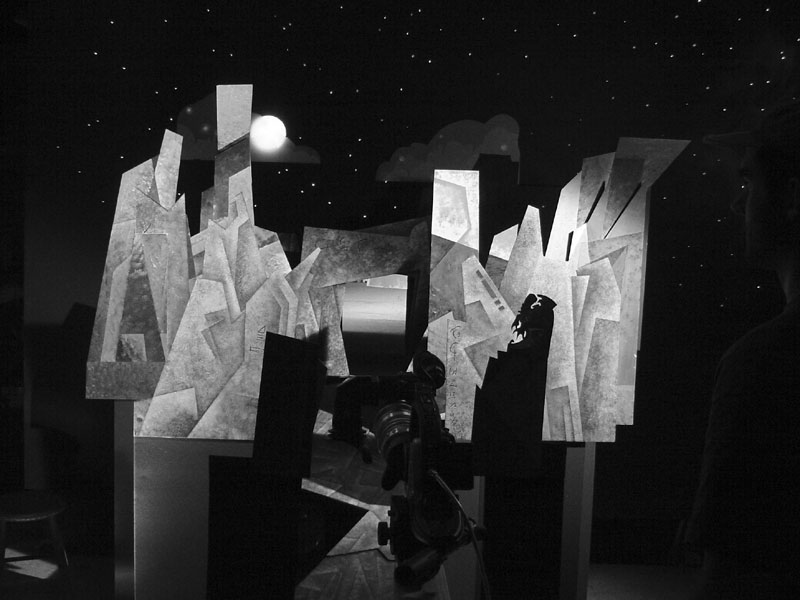 Live-action photography has officially wrapped on the film. The three sets for the dream sequences were carefully built and painted. Each was designed to use specific techniques of special effects photography from the 1920s to put our actors into the hellish geometry and architecture of their dream R'lyeh. The design of the sets was enhanced with lighting, costume and makeup designs especially tailored to the R'lyehs of the unconscious minds of Wilcox and The Man. Shooting went smoothly through these very precise setups. The production now moves onward to focus on music, miniatures and models. And our editors are hard at work, assembling the first rough-cut of the film as 95% of the film is now in the can.
Live-action photography has officially wrapped on the film. The three sets for the dream sequences were carefully built and painted. Each was designed to use specific techniques of special effects photography from the 1920s to put our actors into the hellish geometry and architecture of their dream R'lyeh. The design of the sets was enhanced with lighting, costume and makeup designs especially tailored to the R'lyehs of the unconscious minds of Wilcox and The Man. Shooting went smoothly through these very precise setups. The production now moves onward to focus on music, miniatures and models. And our editors are hard at work, assembling the first rough-cut of the film as 95% of the film is now in the can.
Once More Into the Swamp
 We welcomed the vernal equinox by once more shooting footage. Andrew completed the glorious miniature swamp set. The swamp was built at 1/24th scale, with some miniatures also at 1/6th scale for closeups. Armed with lots of fog, we filmed ample footage of the swamp. This miniature set, which took about 6 weeks to build, will now be struck to make way for upcoming shoots of ships at sea.
We welcomed the vernal equinox by once more shooting footage. Andrew completed the glorious miniature swamp set. The swamp was built at 1/24th scale, with some miniatures also at 1/6th scale for closeups. Armed with lots of fog, we filmed ample footage of the swamp. This miniature set, which took about 6 weeks to build, will now be struck to make way for upcoming shoots of ships at sea.
Stop Motion
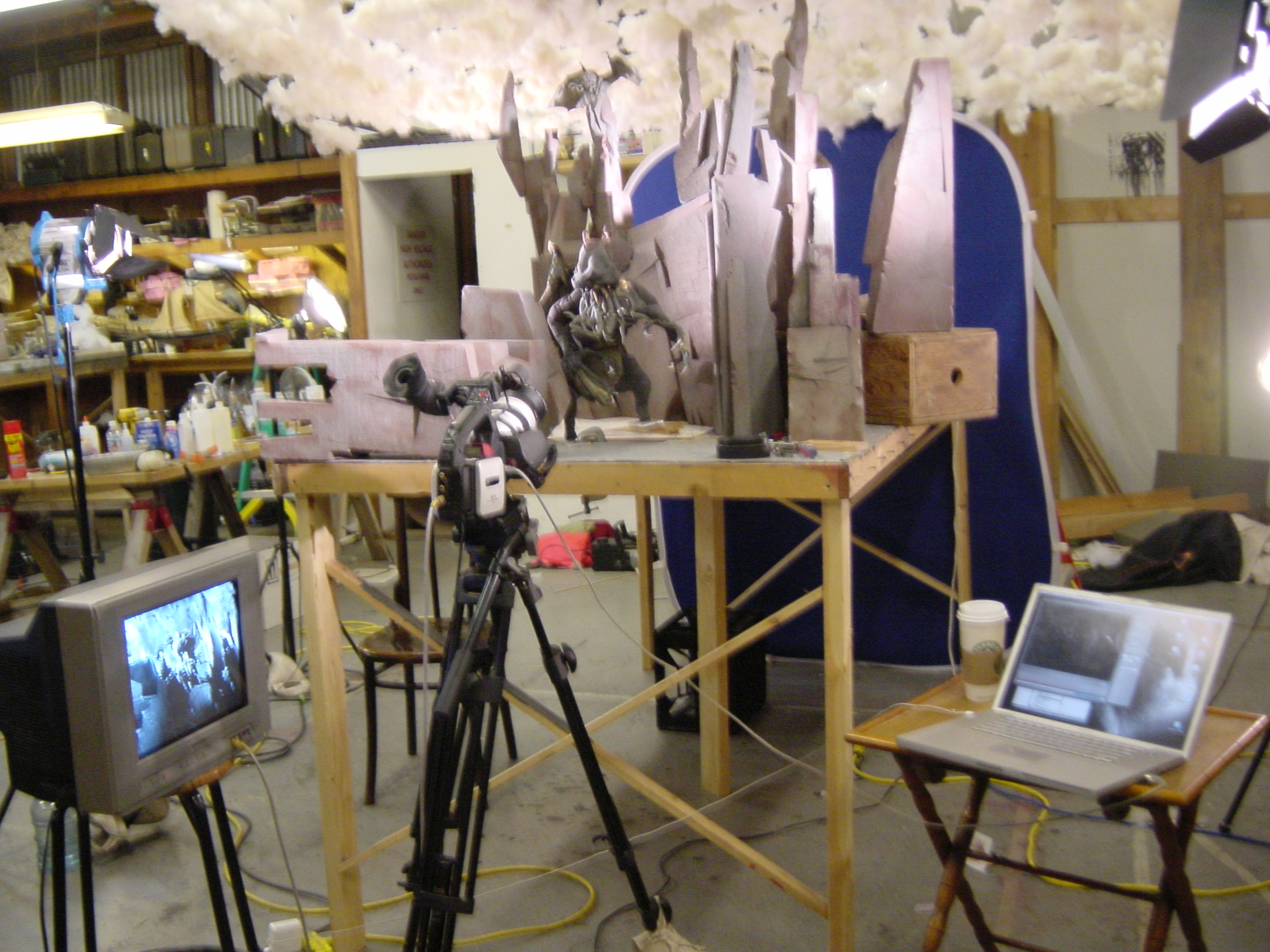 R'lyeh was built in three different scales for various shots. There was the full-size set on which the actors climbed during principal photography. Then there was a very small miniature of the entire city as seen from a distance. And then there was the medium size version for shooting the stop-motion puppet.
R'lyeh was built in three different scales for various shots. There was the full-size set on which the actors climbed during principal photography. Then there was a very small miniature of the entire city as seen from a distance. And then there was the medium size version for shooting the stop-motion puppet.
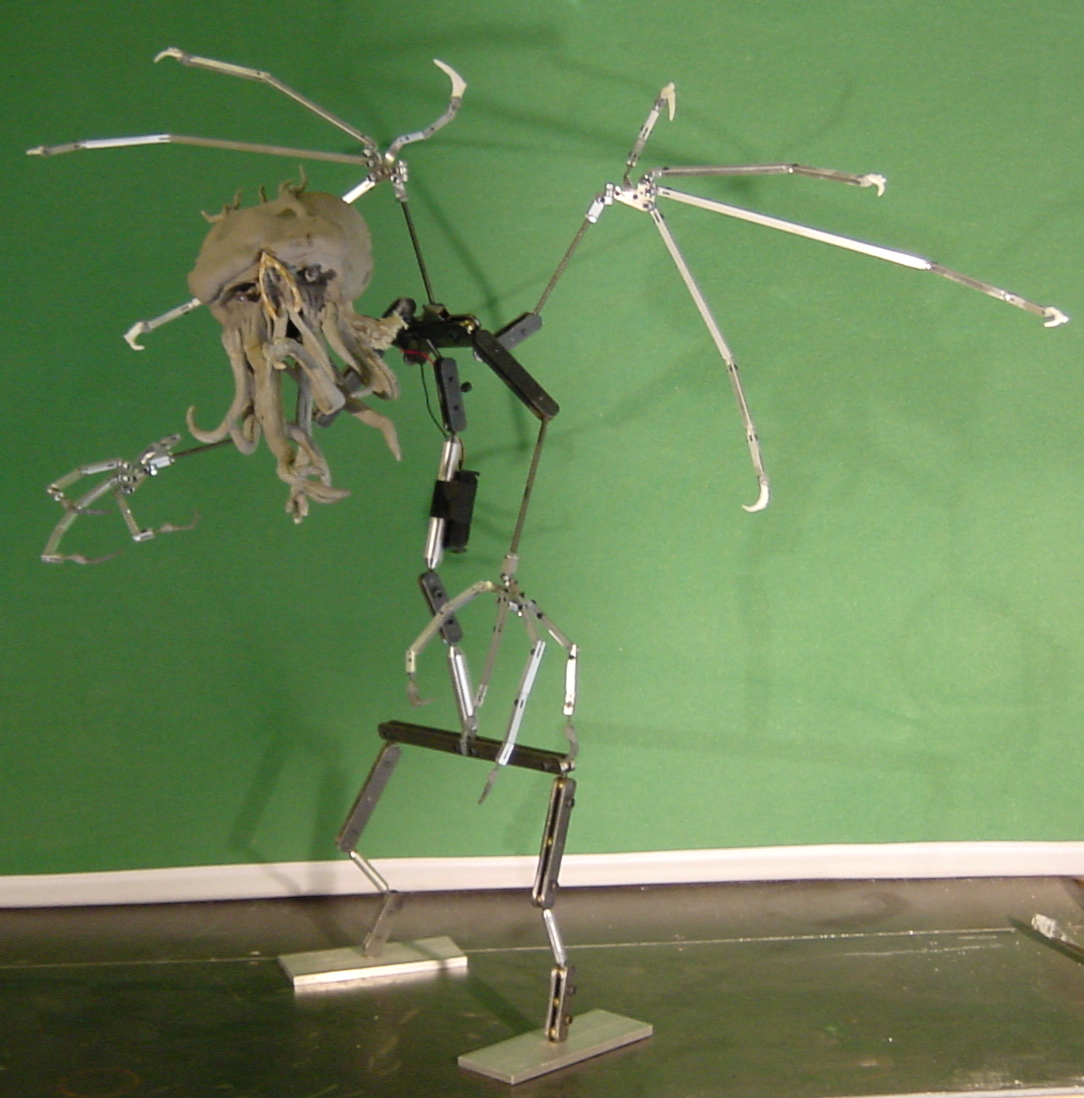 The armature of the puppet was engineered and built by Terry Sandin. The skeleton had almost 100 points of articulation, not counting the tentacles which were all wired. Andrew sculpted the head, hands and wings, which were molded and cast in latex, and made the rest of the body out of fabric. For Cthulhu's gills, Andrew made a silicone mold of crinkly cabbage leaves and cast them in delicate latex. Two tiny battery powered light bulbs were used for the eyes, and they made it possible to keep track of Cthulhu's face in the usually very dark lighting of the scene. Without those burning eyes it would have been much more difficult to animate the puppet. Stop-motion photography is a very slow and painstaking process!
The armature of the puppet was engineered and built by Terry Sandin. The skeleton had almost 100 points of articulation, not counting the tentacles which were all wired. Andrew sculpted the head, hands and wings, which were molded and cast in latex, and made the rest of the body out of fabric. For Cthulhu's gills, Andrew made a silicone mold of crinkly cabbage leaves and cast them in delicate latex. Two tiny battery powered light bulbs were used for the eyes, and they made it possible to keep track of Cthulhu's face in the usually very dark lighting of the scene. Without those burning eyes it would have been much more difficult to animate the puppet. Stop-motion photography is a very slow and painstaking process!
